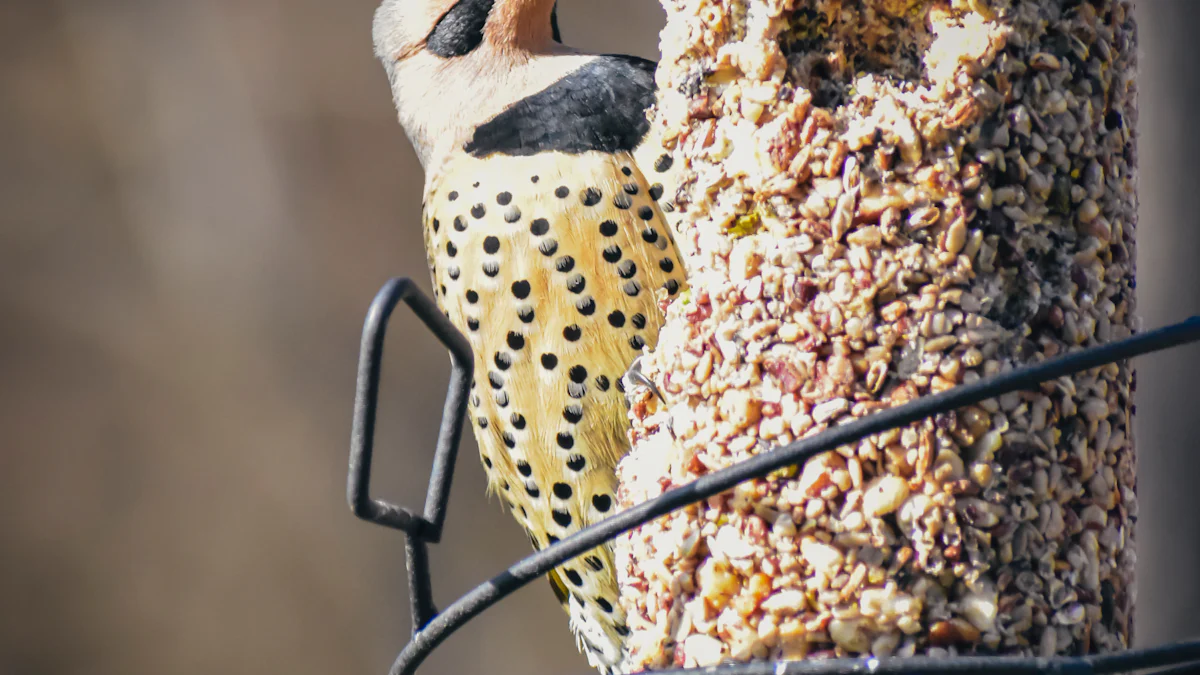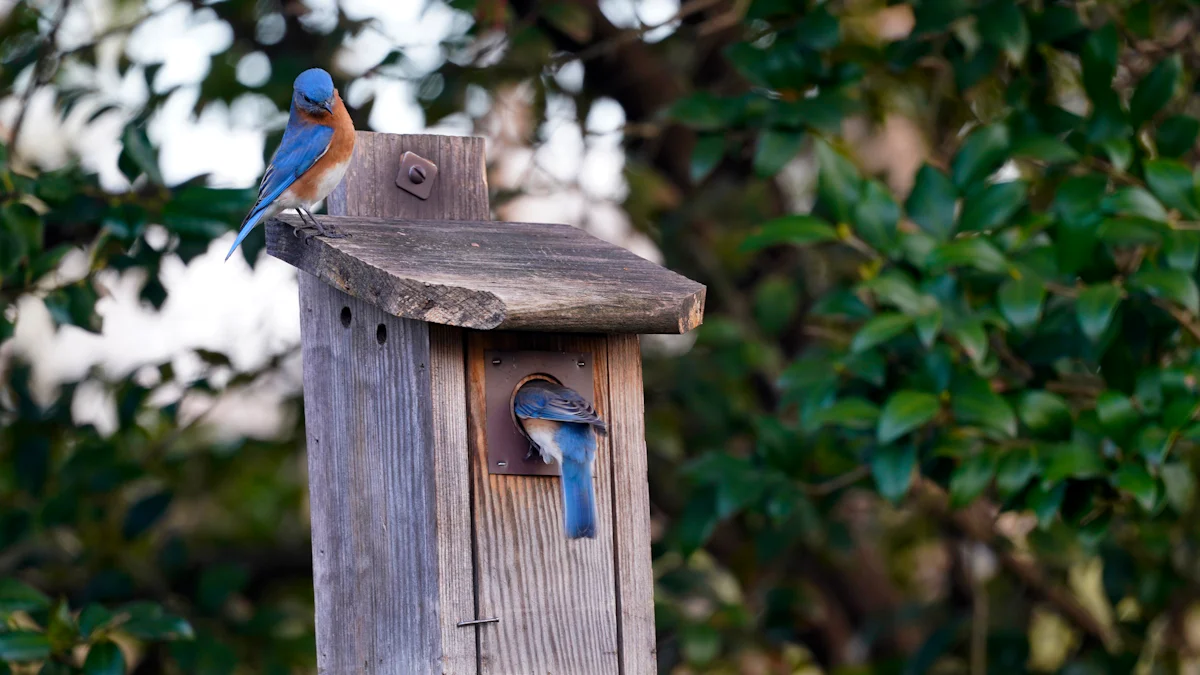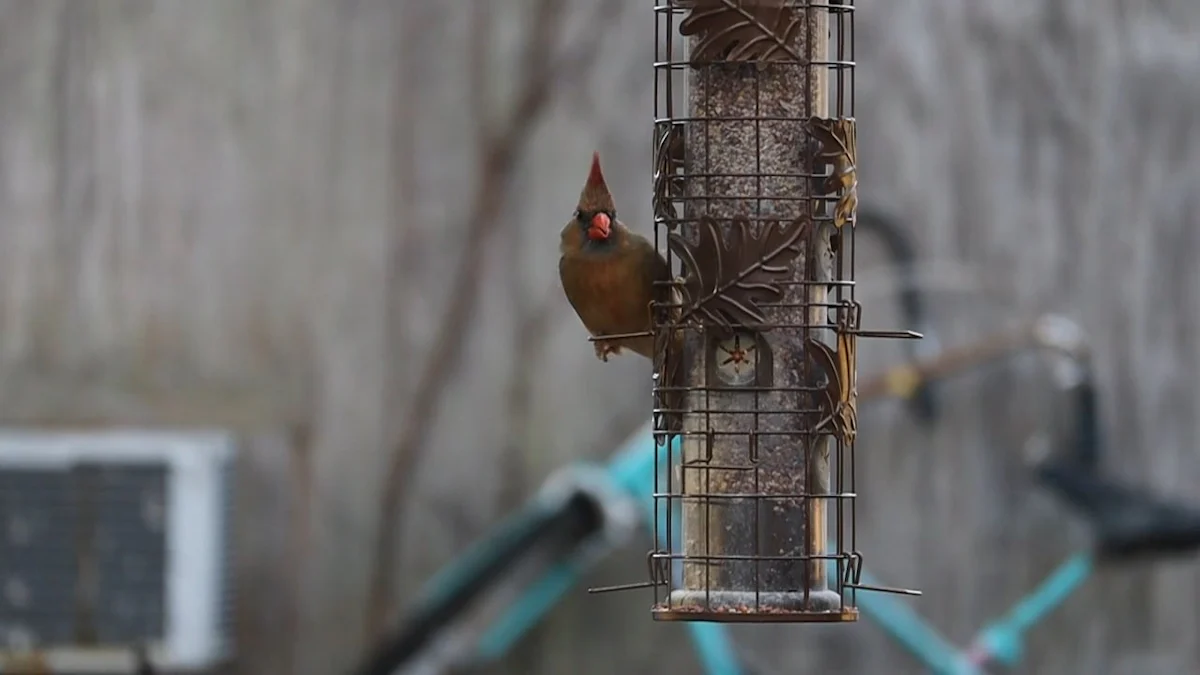
Dried mealworms offer a powerhouse of nutrition for wild birds, packed with essential proteins, fats, and nutrients that fuel their energy and health. With approximately 50% protein and 25% fat, wild birds dried mealworms provide the perfect balance to support feather growth, vibrant plumage, and overall vitality. Birds thrive on this high-quality protein, which matches their dietary needs and keeps them active year-round. Unlike live mealworms, dried ones are easy to store and serve, making them a practical choice for you to attract and nourish a variety of bird species effortlessly.
Key Takeaways
- Dried mealworms are a nutrient powerhouse, providing approximately 50% protein and 25% fat, essential for birds’ energy, feather growth, and overall health.
- These mealworms are easy to store and serve, making them a practical choice for attracting a variety of bird species throughout the year.
- Offering dried mealworms supports birds during critical life stages such as breeding, molting, and migration, ensuring they receive the energy they need.
- Mixing dried mealworms with other bird foods, like seeds and fruits, creates a balanced diet that attracts a wider range of bird species.
- Establishing a consistent feeding schedule helps birds recognize your yard as a reliable food source, enhancing your birdwatching experience.
- Dried mealworms are safe and convenient, with a long shelf life, making them a reliable option for bird enthusiasts.
Nutritional Benefits of Wild Birds Dried Mealworms

High Protein Content for Energy and Growth
Protein plays a vital role in the lives of wild birds. It fuels their energy, supports muscle development, and aids in tissue repair. Wild Birds Dried Mealworms deliver an impressive protein content of approximately 50%, making them an exceptional source of this essential nutrient. This high-quality protein closely matches the amino acid profile that birds need, ensuring they receive optimal nourishment. Whether birds are foraging in your backyard or preparing for long migrations, this protein-packed food keeps them active and resilient.
Studies have shown that insect protein, like that found in mealworms, provides the perfect balance of amino acids for birds. This makes dried mealworms a superior choice compared to many other bird feed options.
By offering Wild Birds Dried Mealworms, you provide a reliable energy source that helps birds thrive in every season.
Essential Fats and Fiber for Overall Health
Fats are more than just an energy reserve for birds. They help maintain body warmth during colder months and support overall health. Wild Birds Dried Mealworms contain about 25% fat, which gives birds the stamina they need to survive harsh weather conditions. These fats also contribute to vibrant plumage, ensuring birds look their best while staying healthy.
Fiber, though often overlooked, plays a crucial role in digestion. The natural fiber in dried mealworms promotes a healthy digestive system, helping birds process their meals efficiently. This combination of fats and fiber makes Wild Birds Dried Mealworms a balanced and wholesome food choice.
Feeding birds dried mealworms not only satisfies their hunger but also keeps them feeling full and energized. This makes it easier for them to focus on other survival tasks, such as finding shelter or caring for their young.
Supporting Birds During Breeding, Molting, and Migration
Certain periods in a bird’s life demand extra energy and nutrients. Breeding season, for instance, requires birds to expend significant energy building nests, laying eggs, and feeding their chicks. The high protein and fat content in Wild Birds Dried Mealworms provide the extra boost they need during this time.
Molting, when birds shed old feathers and grow new ones, is another energy-intensive phase. The protein in mealworms promotes healthy feather growth and strengthens feather durability. This ensures birds remain well-insulated and capable of flight.
Migration presents yet another challenge. Birds travel hundreds or even thousands of miles, often with limited access to food. Dried mealworms act as a compact, nutrient-dense energy source that helps sustain them throughout their journey.
Research highlights that dried mealworms improve feather coloration and strength, making them indispensable during molting and migration.
By incorporating Wild Birds Dried Mealworms into your feeding routine, you support birds during these critical life stages, ensuring they stay strong and healthy year-round.
Practical Advantages of Wild Birds Dried Mealworms
Long Shelf Life and Easy Storage
Dried mealworms offer unmatched convenience with their long shelf life. Unlike live mealworms, which require refrigeration and constant care, dried mealworms can be stored for months without losing their nutritional value. You only need to keep them in a cool, dry place, away from direct sunlight, to maintain their freshness. Using an airtight container prevents moisture and contamination, ensuring the mealworms remain safe and ready to use whenever you need them.
Proper storage not only extends the shelf life but also preserves the nutritional integrity of dried mealworms, making them a reliable food source for wild birds year-round.
This ease of storage allows you to buy in bulk, reducing the hassle of frequent purchases and ensuring you always have a steady supply for your feathered visitors.
Convenient and Mess-Free Feeding Option
Feeding wild birds can sometimes get messy, but dried mealworms eliminate that problem. They are clean, lightweight, and easy to handle, making them a perfect choice for bird enthusiasts. Unlike live mealworms, which require special handling and can escape their containers, dried mealworms are hassle-free. You can simply scoop them out and place them in your bird feeder without worrying about spills or unpleasant odors.
Many bird lovers appreciate the simplicity of dried mealworms. They save time and effort while still providing a high-quality food source for birds.
This mess-free option makes it easier for you to enjoy the experience of feeding birds without the added stress of cleanup.
Suitable for All Weather Conditions
Dried mealworms perform exceptionally well in all weather conditions. Their dehydrated form prevents spoilage, even in hot or humid climates, as long as they are stored properly. During colder months, when natural food sources become scarce, dried mealworms provide a reliable energy boost for birds. Their durability ensures they remain intact and edible, whether it’s raining, snowing, or sunny outside.
Unlike other bird foods that may freeze or spoil, dried mealworms retain their quality, making them a dependable choice throughout the year.
By offering Wild Birds Dried Mealworms, you ensure that your backyard birds receive consistent nutrition, no matter the season or weather.
Bird Species That Enjoy Wild Birds Dried Mealworms

Common Backyard Birds That Eat Mealworms
Many common backyard birds eagerly consume dried mealworms, making them a fantastic addition to your feeder. Species like chickadees, nuthatches, and titmice find these protein-packed treats irresistible. These birds often rely on high-energy foods to fuel their active lifestyles, and dried mealworms provide the perfect solution.
Eastern Bluebirds, in particular, show a strong preference for feeders stocked with dried mealworms. A case study from the Cornell Lab of Ornithology revealed that bluebirds consistently chose mealworm-filled feeders over those containing only seeds. This preference becomes even more pronounced during breeding season when their nutritional needs increase. By offering Wild Birds Dried Mealworms, you can attract these vibrant songbirds and enjoy their cheerful presence in your yard.
“A study by the North American Bluebird Society also highlighted how bluebirds frequently visit feeders with mealworms, especially during breeding season.”
Wrens, another common backyard visitor, also benefit from dried mealworms. Research published in the Journal of Field Ornithology found that providing mealworms significantly increased wren visitation rates, particularly when they needed protein-rich food for their young. Adding mealworms to your feeder ensures these delightful birds keep coming back.
Seasonal Visitors and Migratory Birds
Dried mealworms don’t just appeal to year-round residents; they also attract seasonal visitors and migratory birds. During migration, birds like warblers and orioles require nutrient-dense food to sustain their long journeys. Mealworms offer the energy boost they need to complete these demanding flights.
In spring and fall, you may notice an influx of migratory species stopping by your feeder. These birds often seek out high-protein options to replenish their energy reserves. By including dried mealworms in your feeding routine, you create a reliable food source that supports these travelers during their critical journeys.
“Research shows that dried mealworms act as a compact, nutrient-rich energy source, making them indispensable for migratory birds.”
Seasonal visitors, such as robins and thrushes, also benefit from mealworms. These birds often struggle to find insects during colder months or early spring. Offering dried mealworms helps them bridge the gap until natural food sources become more abundant.
Attracting a Variety of Insect-Eating Birds
Dried mealworms are a magnet for insect-eating birds, drawing a diverse range of species to your yard. Birds like woodpeckers, flycatchers, and even some sparrows enjoy this protein-rich treat. Their natural diet consists of insects, so mealworms closely mimic what they would typically forage for in the wild.
Using specialized feeders, such as Erva’s Starling Proof Mealworm Feeder, can help you cater to specific species like Eastern Bluebirds and Carolina Wrens. These feeders ensure that smaller birds can access the mealworms without interference from larger, more aggressive birds. By investing in the right feeder, you can create a welcoming environment for a variety of insect-eating birds.
“Feeding dried mealworms not only attracts a wide range of birds but also enhances the diversity of wildlife in your backyard.”
Adding Wild Birds Dried Mealworms to your feeder transforms your yard into a haven for insect-eating birds. You’ll enjoy the beauty and activity of these fascinating creatures while providing them with the nutrition they need to thrive.
Best Practices for Serving Wild Birds Dried Mealworms
Choosing the Right Feeder for Mealworms
Selecting the appropriate feeder ensures that birds can easily access the mealworms while keeping them safe from pests and larger, aggressive birds. Specialized feeders, such as mealworm trays, window feeders, or ground feeders, work well for serving dried mealworms. For smaller birds like chickadees and bluebirds, consider using feeders designed with protective cages. These feeders prevent larger birds or squirrels from monopolizing the food.
If you want to attract a variety of species, try using a bird table or an open tray feeder. These options allow multiple birds to feed simultaneously, creating a lively and engaging birdwatching experience. For added convenience, look for feeders that are easy to clean and refill. Keeping feeders clean prevents contamination and ensures the mealworms remain fresh and safe for birds.
“Using a mealworm feeder not only attracts diverse bird species but also enhances your backyard’s ecosystem by supporting wildlife.”
By choosing the right feeder, you create a welcoming environment that encourages frequent visits from your feathered friends.
Mixing Mealworms with Other Bird Foods
While dried mealworms are rich in protein and fat, they should not serve as the sole food source for wild birds. Mixing mealworms with other bird foods, such as seeds, nuts, or suet, provides a balanced diet that meets birds’ nutritional needs. This combination attracts a wider variety of species, including robins, woodpeckers, and nuthatches, which may not visit feeders stocked with seeds alone.
To prepare a nutritious mix, combine dried mealworms with high-quality birdseed or suet cakes. You can also sprinkle mealworms over fruit slices or peanut butter-coated pinecones for an extra treat. This approach not only diversifies the menu but also keeps birds engaged and returning to your yard.
“Adding dried mealworms to your seed mix can entice new bird species to your feeders, enriching your birdwatching experience.”
By offering a variety of foods, you ensure that birds receive the essential nutrients they need to thrive.
Establishing a Feeding Schedule for Year-Round Benefits
Consistency is key when feeding wild birds. Establishing a regular feeding schedule helps birds recognize your yard as a reliable food source. During colder months, provide dried mealworms daily to support birds when natural food sources are scarce. In spring and summer, increase feeding frequency to meet the heightened energy demands of breeding and nesting seasons.
Place mealworms in feeders during early morning hours when birds are most active. Refill feeders as needed, but avoid overstocking to prevent waste or spoilage. Monitor the feeding habits of your local bird population and adjust the schedule accordingly. Regular feeding not only benefits the birds but also enhances your birdwatching opportunities.
“A consistent feeding routine ensures that birds receive the nutrition they need, fostering a thriving and diverse backyard ecosystem.”
By maintaining a year-round feeding schedule, you support the health and wellbeing of wild birds while enjoying their vibrant presence in your yard.
Addressing Common Concerns About Wild Birds Dried Mealworms
Are Dried Mealworms Enough for a Balanced Diet?
Dried mealworms provide exceptional nutrition, but they should not serve as the sole food source for wild birds. While they are rich in protein, fat, and essential nutrients like potassium, magnesium, and B vitamins, birds require a variety of foods to meet their complete dietary needs. A balanced diet ensures they receive all the vitamins, minerals, and energy necessary for survival and optimal health.
“Insect protein, including mealworms, offers high-quality nutrition with an amino acid profile that matches birds’ dietary needs.” — PLOS One Journal
You can think of dried mealworms as a powerful supplement rather than a standalone meal. They work best when combined with other food sources, such as seeds, fruits, and suet. This variety mimics the natural diet of wild birds, which includes insects, grains, and plant matter. By offering a mix of foods, you help birds thrive in every season.
Combining Mealworms with Other Foods for Optimal Nutrition
To maximize the benefits of dried mealworms, combine them with other bird foods. This approach not only enhances the nutritional value but also attracts a wider range of bird species to your feeder. Birds like robins, woodpeckers, and sparrows enjoy diverse diets, and adding mealworms to the mix makes your feeder more appealing.
Here are some effective ways to combine mealworms with other foods:
- Mix with birdseed: Blend dried mealworms with high-quality seeds to create a nutrient-dense mix. This combination appeals to seed-eating birds while providing the protein boost insect-eaters need.
- Pair with suet cakes: Spread mealworms into suet cakes or blocks. This method works especially well during colder months when birds need extra energy.
- Add to fruit slices: Sprinkle mealworms over apple or orange slices. This pairing attracts fruit-loving birds like orioles and tanagers.
“Adding dried mealworms to your seed mix can entice new bird species to your feeders, enriching your birdwatching experience.”
By diversifying the menu, you ensure that birds receive a well-rounded diet while keeping your backyard lively and full of activity.
Ensuring Mealworms Are Safe and Nutritious for Birds
Safety and quality should always come first when feeding wild birds. Dried mealworms are generally safe, but proper storage and handling are essential to maintain their nutritional value. Store them in an airtight container in a cool, dry place to prevent moisture and contamination. Avoid exposing them to direct sunlight, as this can degrade their quality.
“Proper storage not only extends the shelf life but also preserves the nutritional integrity of dried mealworms.”
When purchasing mealworms, choose reputable brands that prioritize quality. Look for products free from additives, preservatives, or artificial coloring. These unnecessary ingredients can harm birds or reduce the nutritional benefits of the mealworms.
Additionally, monitor the quantity you provide. Overfeeding can lead to waste and attract pests. Offer mealworms in moderation, ensuring they complement other food sources rather than replace them entirely.
By following these practices, you guarantee that dried mealworms remain a safe, nutritious, and valuable addition to your bird-feeding routine.
Dried mealworms provide an exceptional way to support wild birds year-round. Their rich protein and fat content fuel birds’ energy, aiding in growth, feather maintenance, and survival during challenging seasons. By incorporating Wild Birds Dried Mealworms into your feeding routine, you attract a variety of species, enhancing your birdwatching experience while contributing to their health and conservation. Following best practices, such as mixing mealworms with other foods and maintaining a consistent feeding schedule, ensures maximum benefits for both you and the birds. Transform your backyard into a haven for vibrant wildlife today.
FAQ
Are dried mealworms good for birds?
Yes, dried mealworms provide excellent nutrition for birds. They are rich in protein, fat, and essential nutrients that support energy, feather growth, and overall health. However, you should use them as part of a balanced diet. Over-reliance on dried mealworms may lead to nutritional imbalances. Mixing them with seeds, fruits, or suet ensures birds receive a variety of nutrients.
“Dried mealworms are a powerful supplement, not a standalone meal. They work best when combined with other food sources.”
Dried Mealworms vs. Live Mealworms – Which is better?
Both dried and live mealworms are safe and beneficial for birds. Live mealworms offer higher moisture content and are closer to what birds eat in the wild. Dried mealworms, on the other hand, are more convenient. They are easy to store, mess-free, and last longer. While live mealworms may provide slightly more benefits, dried mealworms remain an excellent option for feeding wild birds.
“Dried mealworms are a practical choice for bird enthusiasts, offering convenience without compromising on nutrition.”
Can dried mealworms be used for training birds?
Absolutely! Dried mealworms make an excellent treat for training birds. Their high protein content and appealing taste make them irresistible to many bird species. You can use them as rewards to encourage birds to visit specific feeders or even to build trust with backyard visitors. Consistency and patience are key when using mealworms for training.
What types of birds eat dried mealworms?
Dried mealworms attract a wide variety of birds. Common backyard species like robins, bluebirds, chickadees, and nuthatches love them. Seasonal visitors, such as warblers and orioles, also enjoy these treats during migration. Even insect-eating birds like woodpeckers and wrens find dried mealworms irresistible.
“Adding dried mealworms to your feeder enhances the diversity of bird species in your yard, creating a vibrant birdwatching experience.”
How often should I feed dried mealworms to birds?
You can feed dried mealworms daily, but moderation is important. During colder months or breeding seasons, birds may need more energy, so you can increase the frequency. In warmer months, offering mealworms a few times a week is sufficient. Always monitor how much the birds consume to avoid waste or overfeeding.
Are dried mealworms safe for birds?
Yes, dried mealworms are safe when stored and handled properly. Keep them in an airtight container in a cool, dry place to prevent contamination or spoilage. Choose high-quality mealworms free from additives or preservatives. Providing fresh and clean mealworms ensures they remain a nutritious and safe food source for birds.
“Proper storage preserves the nutritional integrity of dried mealworms, making them a reliable option year-round.”
Can dried mealworms help birds during molting?
Yes, dried mealworms are especially beneficial during molting. Feathers are made of protein, and birds need extra protein to grow strong, healthy feathers. The high protein content in mealworms supports feather repair and growth, ensuring birds maintain their insulation and flight capabilities.
What is the best way to serve dried mealworms?
You can serve dried mealworms in various ways. Use specialized feeders like mealworm trays or ground feeders to make them accessible. Mixing mealworms with seeds or suet creates a balanced diet and attracts a wider range of birds. For fruit-loving species, sprinkle mealworms over apple or orange slices.
“Using the right feeder and serving method enhances the appeal of dried mealworms, encouraging more birds to visit your yard.”
Do dried mealworms attract pests?
Dried mealworms are less likely to attract pests compared to live mealworms. However, improper storage or overfeeding can lead to issues. Store mealworms in sealed containers and clean feeders regularly to prevent pests like ants or rodents. Feeding in moderation also helps maintain a clean and pest-free environment.
Why should I include dried mealworms in my bird-feeding routine?
Dried mealworms offer unmatched convenience and nutrition. They provide essential protein and fat, supporting birds during critical life stages like breeding, molting, and migration. By including them in your feeding routine, you attract diverse bird species, enhance your birdwatching experience, and contribute to the wellbeing of wild birds.
“Dried mealworms transform your backyard into a haven for vibrant wildlife, enriching both your garden and your connection to nature.”


